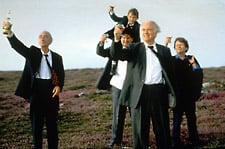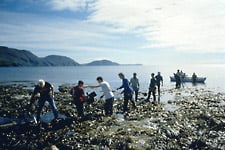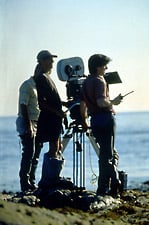by Naomi Pfefferman
Braving the Isle of Man
by Naomi Pfefferman
 |
| The man of Tully More make Ned Devine the toast of the town. |
It's a fact of filmmaking that actors often have to endure harsh weather for the sake of artistry. Waking Ned Devine director Kirk Jones knows this all too well, recalling the heart-stopping moment when a gust of wind nearly propelled his 70-year-old star, Ian Bannen, off the edge of a cliff.
The cast and crew were on location on Britain's Isle of Man, the perfect setting for Jones's charming comedy about two old codgers (Bannen and David Kelly) determined to sniff out a big lottery winner in their sleepy Irish village. On a dark and stormy night, Jackie O'Shea (Bannen) braves the elements to visit lottery regular Ned Devine — who, he discovers, has died of shock while clutching the winning ticket.
"For the wide shot of Ned's cottage, we had to shoot very near the edge of a steep, 400-foot drop," recalls first-time filmmaker Jones, 34, a prominent British commercial director. "We made it as safe as we could, but the wind machine was so powerful that Ian blew back toward the precipice. Fortunately, he sank to his knees, and we managed to turn the machine off. But for a moment there, I thought he was going to get blown over the edge."
The director was inspired to write Devine after reading an amusing newspaper item about a rural postmistress whose neighbors thought she had won the lottery. However, finding the right location for the fictional village of Tully More (population 52) wasn't easy.
Jones initially wanted to set his Irish yarn in Southern Ireland, where he had spent three months completing the script, as well as absorbing "the dialect, the accents and the characters. While in Ireland, I was also looking for a village where I could shoot the film, but I never quite found it. There were plenty of tiny villages, but they tended to be spread out along a road, which would have been difficult to capture in one shot."
 |
| While working on a surreal seaside dream sequence, crew members form a "human chain" to pass equipment to the end of a slippery peninsula. |
Enter Jones's producers, who had learned that The Isle of Man Film Commission offered even better incentives than Ireland for a small production like Devine. Isle officials agreed to provide tax benefits and one-quarter of the movie's $3.5 million budget. "They were very keen on the film, because even in script form it was clear that we would make the island look very beautiful," states Jones, who visited the Isle in February of 1997.
After several hours of scouting, Jones drove over the brow of a hill and came across the perfectly preserved museum village of Cregneash, which he describes as "a cluster of incredibly charming barns and cottages set on a hill with the sea as a backdrop. I thought, 'This is it. This is what I had in mind.'"
During production, which took place in August and September of 1997, Isle officials allowed Jones to use his own crew and to take over the entire village. The director managed to win over the less-than-enthusiastic locals, who eventually served as extras, by telling them the film's story.
Since Jones wanted his movie to have a look of "heightened reality," he utilized existing farmhouses and barns for exteriors. For authenticity's sake, the whitewashed museum-village buildings were done up in a muddy-green wash.
Almost all of the interiors were shot in existing buildings: Fisherman Ned Devine's house, for example, was set in a tiny cottage overlooking the sea. Whenever the actors opened the front door, the camera was able to capture the cove and the sparkling water below.
Two other key sets, Jackie's farmhouse and the village pub, were built within barns in Cregneash. The walls were smeared with uneven plaster, then papered with vintage 1970s wallpaper to look like the rural homes Jones had seen during his travels in Ireland.
To enhance the impression of dark, cozy interiors, cinematographer Henry Braham, BSC (The Land Girls, Shooting Fish and Roseanna's Grave — see AC March '97 for coverage on the latter) drew upon the paintings of Rembrandt, especially the Dutch artist's self-portraits. "The background is dark but the subject is illuminated by a warm light that allows you to see very clearly into the character," says the 34-year-old cameraman, who has previously worked with Jones on a number of commercials. With his aperture set at T4.5 or 5.6, Braham often lit indoor night scenes with one or two 1K space lights placed very close to the actors.
Even when it was possible, Braham refused to float the walls to allow extra space for his Panavision cameras. "I don't like taking the camera out of the set, because that is rarely believable," affirms the cinematographer, who instead would back the camera up against a wall. "One trick that helped was to slightly oversize the sets, because as long as you know which lens you're going to use, you can give yourself enough room to track the camera around without having to take out the walls."
 |
| Cinematographer Henry Braham (with walkie-talkie) supervises a scenic setup. |
Braham arrived in Cregneash for the 34-day shoot with two Panaflex GII outfits and Primo lenses, along with heater blankets designed by Panavision to protect the lenses in case of bad weather. To handle the Isle's changeable weather, he employed Kodak's 200 ASA EXR 5293 stock for interiors and Vision 250D 5246 for exteriors. For lighting exteriors, he mainly utilized two 18K HMIs and four 6K HMI Cinepars; interiors were illuminated with Kino Flo Wall-O-Lites and space lights.
During prep, Jones rewrote several scenes to take advantage of the Isle's rugged beauty. A surreal dream sequence, for example, was moved from a ballroom to a boat on the sunlit sea. "To do the sequence, 16 of us had to form a human chain to pass the equipment down to the end of a slippery, dangerous peninsula covered in seaweed and slime," the director explains. "The equipment was then carried by boat to a spot further down the peninsula that we couldn't get to on foot. The tide was coming in and we only had about 25 minutes to get the shot. We literally shot to the last moment. If we had left five minutes later, we would have been underwater."
When Jones reworked the script to include a shot of a seal on an island off the Isle's coast, Braham embarked on the shoot's most precarious endeavor. "I took my camera operator, focus puller and loader out to the island one morning at 5 a.m. on this fishing boat driven by a salty old fisherman who thought we'd gone bonkers," the cinematographer recalls. "The sea was very rough, the boat stank of fish, and all of my chaps were quite green [around the gills]. We took only minimal equipment — no lights and just the long zoom — and by lunchtime we'd gotten several shots. We'd also fallen flat on our faces numerous times, cutting ourselves to shreds on the barnacles."
While the island's elements provided dramatic seascapes and sunsets, it also demanded clever improvising on the cinematographer's part. "One thing about shooting on an island in the middle of the Irish Sea is that the weather changes fantastically quickly," notes Braham, who frequently consulted with forecasters during production.
The cameraman had wanted to shoot Waking Ned Devine's funeral sequence in bright sunlight, but the sequence wound up being filmed in conditions that ranged from sun to fog to thunderstorms. "It was almost pitch black outside when we shot the funeral service inside the church," says Braham, "so I matched the exposure of the interior for the exterior and was careful not to show too much of the windows in the frame."
Another comical sequence provided a very different kind of challenge for 69-year-old actor David Kelly, who portrays Michael O'Sullivan, a man whose impersonation of Ned Devine allows the villagers to cash in on the dead man's lottery ticket. When the lottery official pays an unexpected visit to the village, O'Sullivan, who had been skinny-dipping, hops on a motorcycle and races to Ned's house — buck naked. Filming of the scene gave two elderly local women, who were driving by in a Mini, quite a shock. "We were towing him on a motorcycle rig, but it was still quite scary for him because he'd never ridden a motorbike before and we were traversing these windy little country roads," remembers Braham, who shot the sequence with a Steadicam. "It was September, and he was freezing his behind off. Plus, we had to ask him to remove the special body stocking we had designed for privacy; it didn't work because I could see it in the frame, and it kept causing him to slide around dangerously on the seat of the motorbike."
Waking Ned Devine ends with a breathtaking aerial shot of the protagonists toasting the late Devine at the edge of a cliff. "Kirk and I scouted that location while flying around the island in a horrible, tiny airplane at 6 a.m. one morning," offers Braham, who did the helicopter camerawork himself. "I've never felt so sick in my life. Finally, we spotted this ideal location, which, it turned out, was impossible to get to on foot. We also couldn't do the shot for two days because the place was completely fogged-in.
"When the light finally broke, we knew we had to go for it. It was very windy, and the light was changing all the time. I kept picking the actors up and dropping them off, via the support helicopter, to line them up with the sun and the light on the water. What we hadn't counted on was how deep the heather was up there; it was knee-deep, and the elderly actors were struggling to walk around in it. We finally got the shot, but only by the skin of our teeth!"
© 1999 ASC